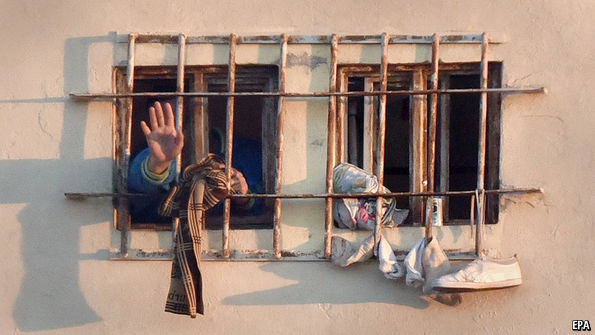A murderous fight shows the problems afflicting the penal system

MEXICO’S prisons are dark, violent places. Their dismal state was horrifically revealed on the morning of February 11th, after at least 49 inmates died during a riot in a prison in the north-eastern state of Nuevo León. Early reports suggested that the fight was between prisoners linked to the Zetas, a drug gang, and their rivals in north-eastern Mexico, the Gulf gang. According to the state’s governor, Jaime Rodríguez, the confrontation was in fact an internecine Zeta affair.
It started late on February 10th in Topo Chico prison, in the state capital of Monterrey, and was brought under control after two hours. Mr Rodríguez, said guns were not used; instead, the prisoners wielded “sharp weapons, bats and sticks”. Parts of the prison were set on fire. “It was a pitched battle,” he said, “horrible and terrifying.” (Mexican officials will rue not only the tragedy but its timing: Pope Francis began his first visit to Mexico on February 12th.)
The fight is believed to be the most deadly in the country’s penal history. In February 2012, 44 prisoners, from the Zeta and Gulf gangs, were killed in a brawl at another prison in Nuevo León; the month before that, 31 died at a prison in Tamaulipas to the east. It is a problem with various contributing strands: overcrowding, a lack of guards, unmodernised buildings and the presence of inmates intent on continuing deadly rivalries fomented in the outside world.
That Mexican prisons are a mess will surprise few people. Joaquín Guzmán (El Chapo), head of the Sinaloa drug gang, drew attention to one sort of failing when he escaped from a federal prison through a mile-long tunnel last July. He was recaptured in January.
The tragedy at Topo Chico, a state prison, highlights other faults. The average Mexican prison has 30% more inmates than it is built for, according to the Global Impunity Index, which was recently published by the University of the Americas in Puebla, south-east of Mexico City. Further problems are caused by mixing prisoners serving sentences with those awaiting trial, and by putting prisoners sentenced locally, who are near their families, with federal prisoners, who may be far away from theirs.
Many prisons combine overcrowding with a skeleton crew of guards. The average ratio in 59 countries is nearly one guard for every two prisoners, according to the impunity report. In Mexico the guard-prisoner ratio is 1:5, and in Topo Chico, says Mr Rodríguez, it is 1:38—“the result of a serious lack of attention to the penitentiary system”.
Mexico’s prison guards are also poorly paid and motivated. So it is quite common, especially in state prisons, for inmates to be given some unofficial responsibility for governance. In theory, this makes it easier to control inmates’ behaviour. But it also allows them to continue criminal activity and does not protect them from one another, as the events at Topo Chico show.
During the presidency of Felipe Calderón, from 2006 to 2012, money was poured into the building of new federal prisons.What is needed more is investment in new and existing state-run prisons where the vast majority of felons live. The structures of justice and prisons have not changed in 15 years, says Gerardo Rodríguez, professor of national security at the University of the Americas. A federal justice reform due to be implemented across Mexico this year introduces oral trials and encourages the use of alternative procedures, such as mediation, which are less likely to lead to prison sentences. This could reduce overcrowding eventually.
Now Mexico must upgrade prison infrastructure, professionalise the corps of prison guards and expand the number of judges, to reduce the number of inmates awaiting trial (36% of the prison population). Without such changes, tragedies like the one at Topo Chico will continue to happen.
In a video released last week Pope Francis said, “The Mexico of violence, the Mexico of corruption, the Mexico of drug trafficking, the Mexico of cartels, is not the Mexico our Mother [the Virgin of Guadalupe, the country’s patron] wants.” Sadly, that is the Mexico people will be talking about during his visit.

No comments:
Post a Comment